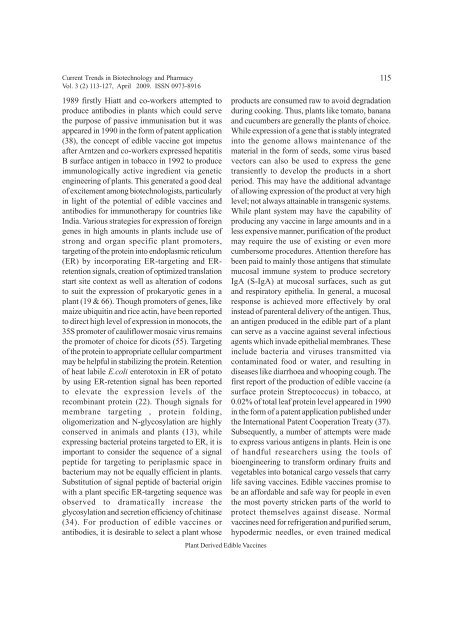April Journal-2009.p65 - Association of Biotechnology and Pharmacy
April Journal-2009.p65 - Association of Biotechnology and Pharmacy
April Journal-2009.p65 - Association of Biotechnology and Pharmacy
Create successful ePaper yourself
Turn your PDF publications into a flip-book with our unique Google optimized e-Paper software.
Current Trends in <strong>Biotechnology</strong> <strong>and</strong> <strong>Pharmacy</strong><br />
Vol. 3 (2) 113-127, <strong>April</strong> 2009. ISSN 0973-8916<br />
115<br />
1989 firstly Hiatt <strong>and</strong> co-workers attempted to<br />
produce antibodies in plants which could serve<br />
the purpose <strong>of</strong> passive immunisation but it was<br />
appeared in 1990 in the form <strong>of</strong> patent application<br />
(38), the concept <strong>of</strong> edible vaccine got impetus<br />
after Arntzen <strong>and</strong> co-workers expressed hepatitis<br />
B surface antigen in tobacco in 1992 to produce<br />
immunologically active ingredient via genetic<br />
engineering <strong>of</strong> plants. This generated a good deal<br />
<strong>of</strong> excitement among biotechnologists, particularly<br />
in light <strong>of</strong> the potential <strong>of</strong> edible vaccines <strong>and</strong><br />
antibodies for immunotherapy for countries like<br />
India. Various strategies for expression <strong>of</strong> foreign<br />
genes in high amounts in plants include use <strong>of</strong><br />
strong <strong>and</strong> organ specific plant promoters,<br />
targeting <strong>of</strong> the protein into endoplasmic reticulum<br />
(ER) by incorporating ER-targeting <strong>and</strong> ERretention<br />
signals, creation <strong>of</strong> optimized translation<br />
start site context as well as alteration <strong>of</strong> codons<br />
to suit the expression <strong>of</strong> prokaryotic genes in a<br />
plant (19 & 66). Though promoters <strong>of</strong> genes, like<br />
maize ubiquitin <strong>and</strong> rice actin, have been reported<br />
to direct high level <strong>of</strong> expression in monocots, the<br />
35S promoter <strong>of</strong> cauliflower mosaic virus remains<br />
the promoter <strong>of</strong> choice for dicots (55). Targeting<br />
<strong>of</strong> the protein to appropriate cellular compartment<br />
may be helpful in stabilizing the protein. Retention<br />
<strong>of</strong> heat labile E.coli enterotoxin in ER <strong>of</strong> potato<br />
by using ER-retention signal has been reported<br />
to elevate the expression levels <strong>of</strong> the<br />
recombinant protein (22). Though signals for<br />
membrane targeting , protein folding,<br />
oligomerization <strong>and</strong> N-glycosylation are highly<br />
conserved in animals <strong>and</strong> plants (13), while<br />
expressing bacterial proteins targeted to ER, it is<br />
important to consider the sequence <strong>of</strong> a signal<br />
peptide for targeting to periplasmic space in<br />
bacterium may not be equally efficient in plants.<br />
Substitution <strong>of</strong> signal peptide <strong>of</strong> bacterial origin<br />
with a plant specific ER-targeting sequence was<br />
observed to dramatically increase the<br />
glycosylation <strong>and</strong> secretion efficiency <strong>of</strong> chitinase<br />
(34). For production <strong>of</strong> edible vaccines or<br />
antibodies, it is desirable to select a plant whose<br />
Plant Derived Edible Vaccines<br />
products are consumed raw to avoid degradation<br />
during cooking. Thus, plants like tomato, banana<br />
<strong>and</strong> cucumbers are generally the plants <strong>of</strong> choice.<br />
While expression <strong>of</strong> a gene that is stably integrated<br />
into the genome allows maintenance <strong>of</strong> the<br />
material in the form <strong>of</strong> seeds, some virus based<br />
vectors can also be used to express the gene<br />
transiently to develop the products in a short<br />
period. This may have the additional advantage<br />
<strong>of</strong> allowing expression <strong>of</strong> the product at very high<br />
level; not always attainable in transgenic systems.<br />
While plant system may have the capability <strong>of</strong><br />
producing any vaccine in large amounts <strong>and</strong> in a<br />
less expensive manner, purification <strong>of</strong> the product<br />
may require the use <strong>of</strong> existing or even more<br />
cumbersome procedures. Attention therefore has<br />
been paid to mainly those antigens that stimulate<br />
mucosal immune system to produce secretory<br />
IgA (S-IgA) at mucosal surfaces, such as gut<br />
<strong>and</strong> respiratory epithelia. In general, a mucosal<br />
response is achieved more effectively by oral<br />
instead <strong>of</strong> parenteral delivery <strong>of</strong> the antigen. Thus,<br />
an antigen produced in the edible part <strong>of</strong> a plant<br />
can serve as a vaccine against several infectious<br />
agents which invade epithelial membranes. These<br />
include bacteria <strong>and</strong> viruses transmitted via<br />
contaminated food or water, <strong>and</strong> resulting in<br />
diseases like diarrhoea <strong>and</strong> whooping cough. The<br />
first report <strong>of</strong> the production <strong>of</strong> edible vaccine (a<br />
surface protein Streptococcus) in tobacco, at<br />
0.02% <strong>of</strong> total leaf protein level appeared in 1990<br />
in the form <strong>of</strong> a patent application published under<br />
the International Patent Cooperation Treaty (37).<br />
Subsequently, a number <strong>of</strong> attempts were made<br />
to express various antigens in plants. Hein is one<br />
<strong>of</strong> h<strong>and</strong>ful researchers using the tools <strong>of</strong><br />
bioengineering to transform ordinary fruits <strong>and</strong><br />
vegetables into botanical cargo vessels that carry<br />
life saving vaccines. Edible vaccines promise to<br />
be an affordable <strong>and</strong> safe way for people in even<br />
the most poverty stricken parts <strong>of</strong> the world to<br />
protect themselves against disease. Normal<br />
vaccines need for refrigeration <strong>and</strong> purified serum,<br />
hypodermic needles, or even trained medical













